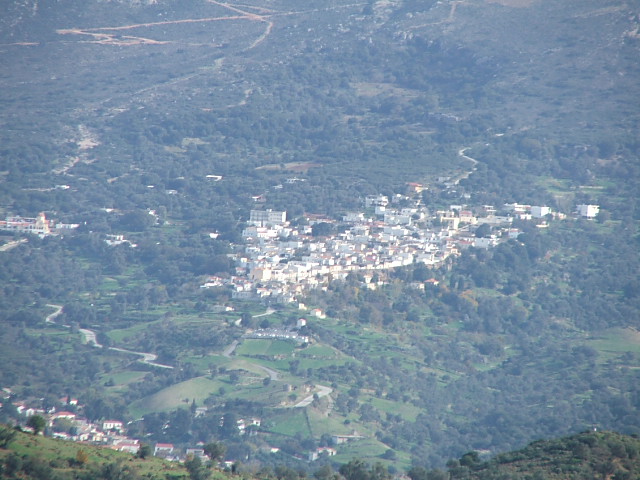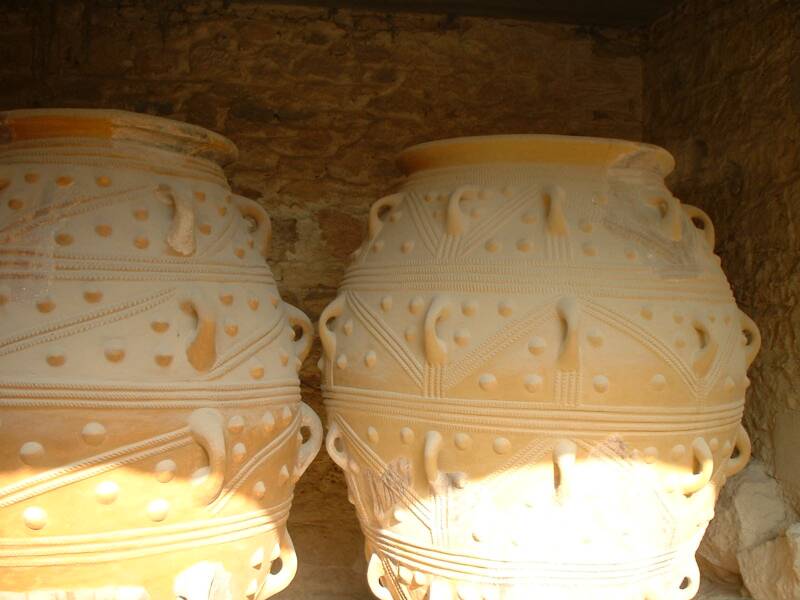 So, not wanting to go home just yet, we went on from Egypt to Crete (or Kreta). I thought at first that the roadsigns were readable, or at least pronounceable, then the alphabet threw a few letters in that I could understand (with a good run up) but can't get my literacy to deal with, like pye or delta. It's hard getting your tongue to say D when your eyes see a badly drawn A. Then it gets harder.
So, not wanting to go home just yet, we went on from Egypt to Crete (or Kreta). I thought at first that the roadsigns were readable, or at least pronounceable, then the alphabet threw a few letters in that I could understand (with a good run up) but can't get my literacy to deal with, like pye or delta. It's hard getting your tongue to say D when your eyes see a badly drawn A. Then it gets harder.
 Some letters are not as obvious, like three horizontal lines pronounced ksee and a thing like a three armed candle-stick which is pronounced psee. Then p is ro and h is eeta. This happens to several letters you think you know, so the expression "all Greek to me" begins to make sense. I suppose it's as complicated as English.
Some letters are not as obvious, like three horizontal lines pronounced ksee and a thing like a three armed candle-stick which is pronounced psee. Then p is ro and h is eeta. This happens to several letters you think you know, so the expression "all Greek to me" begins to make sense. I suppose it's as complicated as English.
 At last, a use for a classical education, wish I had one at this point but I did metalwork,I guess I'd have forgotten it by now, modern students would probably think my education was history anyway.
At last, a use for a classical education, wish I had one at this point but I did metalwork,I guess I'd have forgotten it by now, modern students would probably think my education was history anyway.
 The words often sound familiar, there are a lot of Greek words in the English Language, ask your father. (Pateras) Fortunately the Cretans have been kind enough to put up a secondary traffic signs a few meters past the Greek one with the English phonetic and often a translation.
The words often sound familiar, there are a lot of Greek words in the English Language, ask your father. (Pateras) Fortunately the Cretans have been kind enough to put up a secondary traffic signs a few meters past the Greek one with the English phonetic and often a translation.
 Some idea of what it looks like, First off, it's a lot greener than most of the Mediterranean islands,
Some idea of what it looks like, First off, it's a lot greener than most of the Mediterranean islands,
especially in December, and quite prosperous because of that. It's certainly not as dependant on tourists as Egypt. There are two decent sized mountain ranges and most of the roads go through, or rather over them. The mountains are very precipitous, most of the flat bits are at more than 45 degrees to the vertical. Driving can involve some spectacular views, much more suddenly than your laundry maid would hope for. The local version of crash barrier has regular visual lessons (gaping holes) in what not to do, and where not to do it. If you are lucky there is a practical demonstration of the wrong answer a few hundred meters down slope. If not, well you will be educating others who follow you, but more carefully.
 The Cretans have no fear of heights at all, or hide it well, many of the tiny villages perched on precarious pinnacles and precipices have bits of houses and sheds hanging over such gigantic voids that all the warning the occupant would get would be a single loud snap and then immediate free-fall for at least 30 seconds. And yes it is an earthquake zone.
The Cretans have no fear of heights at all, or hide it well, many of the tiny villages perched on precarious pinnacles and precipices have bits of houses and sheds hanging over such gigantic voids that all the warning the occupant would get would be a single loud snap and then immediate free-fall for at least 30 seconds. And yes it is an earthquake zone.
 The above photo is of a small town on a wide plain.
The above photo is of a small town on a wide plain.
It is taken from a tiny village on the edge of a cliff, so tiny that you can't photograph it, (if you can see it from outside you have your nose stuck against a building, step back and you have fallen off the edge and can't see it any more.)
You can go to the edge and look straight down onto roofs.
I didn't..
I was told this kind of container is called a Jordan
I don't believe it.
 To finish, here are a few well known views.
To finish, here are a few well known views.
The reconstructions of the Palace of King Minos at Knossos are looked on as being a bit "disneyworld" by the serious modern archaeological types, but it does give you a much better feel for the thing than heaps of rubble, and is more photographed than any other site I know in the Med. It's generally a bit iconic for the ancient world, especially if you want something a bit more homely and understandable than a pyramid.
 It really could do with a big roof though, as it is dissolving in the occasional but heavy rain.
It really could do with a big roof though, as it is dissolving in the occasional but heavy rain.

